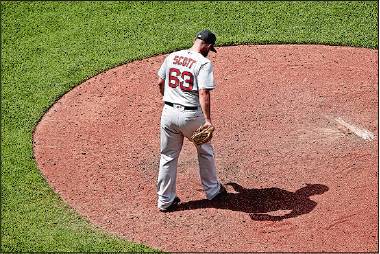RED SOX
Is the pen showing its first cracks?
Relievers have been outstanding, but most lack big-league track records
By Tim Britton Journal Sports Writer
Wednesday's 6-4 loss to the Royals was the kind of game the Red Sox hadn't lost this season.
In one way, this is literal: It was the first time this season that the Sox had dropped a game in which they had led after seven innings. Only the Rockies and White Sox have yet to lose that way this season, and some teams have lost as many as six games in that spot.
It's also anecdotal, in that Boston's traditional flaws were strengths on Wednesday. The Red Sox received a strong start from Drew Pomeranz. They showcased some power in back-to-back home runs from Andrew Benintendi and Xander Bogaerts.
The weakness was what has been one of the team's best competitive advantages this season — its bullpen.
Three walks — two by Matt Barnes, one by Robby Scott, to the team that has walked the least in baseball — preceded Salvador Perez's game-winning grand slam off Scott.
Prior to that eighth inning, Red Sox relievers had allowed six runs in their previous 41 1/3 frames — a collective ERA of 1.31 over a dozen games. The contributions had come from the entire bullpen, whether it be shutdown ninth innings from Craig Kimbrel, situational work from Scott and Heath Hembree, or emergency innings from Hector Velazquez.
But Wednesday’s loss stung because it nudged at a latent insecurity about this team: Yes, the bullpen has been good but how long can it reasonably continue to be this good?
Let’s be clear: Boston’s bullpen has been fantastic this season. Boston has had the bullpen results it expected coming into the season despite not having the roster of relievers it anticipated, enduring the expected absence of Carson Smith and the unexpected one of Tyler Thornburg with little problem. Even after Wednesday’s eighth-inning meltdown, Red Sox relievers own a 2.99 ERA, which ranks second in the American League. That’s not all smoke and mirrors, either. Their strikeout-to-walk ratio ranks fifth.
The bullpen has blown only four wins for starting pitchers this season; the Yankees’ vaunted bullpen has done that nine times.
At the same time, it’s fair to question the sustainability of that success. Baseball is littered with relievers and bullpens capable of half-seasons of elite production, followed promptly by below-average results. Relief performance is fickle, not only across seasons but within them, and beyond Kimbrel, Boston’s bullpen contains pitchers who lack major-league track records.
Barnes has never been a primary setup man before, and he’s never made it through six full months of relief work without a slump. Hembree was essentially a swing-man innings-eater last season. Joe Kelly has never been a full-time, high-leverage reliever, and he’s not yet able to consistently pitch on consecutive days. Scott was barely pitching high-leverage for the PawSox this time last summer.
There are warning signs in individual performance, as well. The ERAs for Kelly and Scott are better than their fielding-independent numbers. Barnes has walked more batters in June than either Chris Sale or Rick Porcello, each of whom has tripled his number of innings.
The bullpen’s collective WHIP and strikeout-to-walk ratios are much worse in June than they were in May, even as the ERA is better.
Additionally, Kimbrel is on pace to throw more innings than he has in any season since 2011. That’s one of the reasons the Red Sox have expressed reluctance to continue using him aggressively in the eighth inning — a reluctance that burned them on Wednesday.
(That seemed like a prime spot to use the closer for more than three outs, given that he hadn’t pitched since Sunday and had an off-day coming on Thursday. After Kimbrel was used for four outs in New York earlier this month, however, both the closer and manager John Farrell talked about not wanting to do that as often. And Wednesday’s situation called for six outs from Kimbrel, if the Red Sox wanted him to indeed close the game.)
Hembree is on pace to throw more innings than he ever has professionally, as well.
Earlier in the season, that looked OK, given that help was expected in the second half from Smith and Thornburg. But Thornburg is now out for the entire season, and the recent optimism around Smith has dissipated now that a rehab assignment has been postponed due to shoulder soreness. Even if Smith returns this season, it’s hard to project that he’d be a regular option in a setup role.
That’s why it might behoove the Red Sox to be proactive on the reliever market in July, even as the bullpen appears to be a strength right now. Boston experienced what a beleaguered bullpen can do to a team last July. Maybe more importantly, it witnessed firsthand what a standout pen can do for a squad come October in its Division Series loss to the Indians.
Is this bullpen good enough for the pennant race? Is it good enough for the postseason? The Red Sox have a month to make that final decision.
